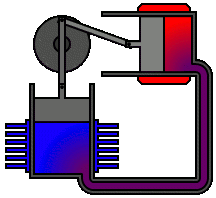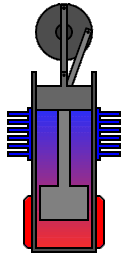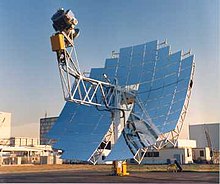The heat source may be provided by the combustion of a fuel and, since the combustion products do not mix with the working fluid and hence do not come into contact with the internal parts of the engine, a Stirling engine can run on fuels that would damage other types of engines’ internals, such as landfill gas which contains siloxane.
Other suitable heat sources include concentrated solar energy, geothermal energy, nuclear energy, waste heat and bioenergy. If solar power is used as a heat source, regular solar mirrors and solar dishes may be utilised. The use of Fresnel lenses and mirrors has also been advocated, for example in planetary surface exploration.[30] Solar powered Stirling engines are increasingly popular as they offer an environmentally sound option for producing power while some designs are economically attractive in development projects.[31]
Heater / hot side heat exchanger
In small, low power engines this may simply consist of the walls of the hot space(s) but where larger powers are required a greater surface area is needed in order to transfer sufficient heat. Typical implementations are internal and external fins or multiple small bore tubes.
Designing Stirling engine heat exchangers is a balance between high heat transfer with low viscouspumping losses and low dead space (unswept internal volume). With engines operating at high powers and pressures, the heat exchangers on the hot side must be made of alloys that retain considerable strength at temperature and that will also not corrode or creep.
Regenerator
In a Stirling engine, the regenerator is an internal heat exchanger and temporary heat store placed between the hot and cold spaces such that the working fluid passes through it first in one direction then the other. Its function is to retain within the system that heat which would otherwise be exchanged with the environment at temperatures intermediate to the maximum and minimum cycle temperatures,[32] thus enabling the thermal efficiency of the cycle to approach the limiting Carnot efficiency defined by those maxima and minima.
The primary effect of regeneration in a Stirling engine is to increase the thermal efficiency by ‘recycling’ internal heat which would otherwise pass through the engine irreversibly. As a secondary effect, increased thermal efficiency yields a higher power output from a given set of hot and cold end heat exchangers. It is these which usually limit the engine’s heat throughput. In practice this additional power may not be fully realized as the additional “dead space” (unswept volume) and pumping loss inherent in practical regenerators reduces the potential efficiency gains from regeneration.
The design challenge for a Stirling engine regenerator is to provide sufficient heat transfer capacity without introducing too much additional internal volume (‘dead space’) or flow resistance. These inherent design conflicts are one of many factors which limit the efficiency of practical Stirling engines. A typical design is a stack of fine metal wiremeshes, with low porosity to reduce dead space, and with the wire axes perpendicular to the gas flow to reduce conduction in that direction and to maximize convective heat transfer.[33]
The regenerator is the key component invented by Robert Stirling and its presence distinguishes a true Stirling engine from any other closed cycle hot air engine. Many small ‘toy’ Stirling engines, particularly low-temperature difference (LTD) types, do not have a distinct regenerator component and might be considered hot air engines, however a small amount of regeneration is provided by the surface of displacer itself and the nearby cylinder wall, or similarly the passage connecting the hot and cold cylinders of an alpha configuration engine.
Cooler / cold side heat exchanger
In small, low power engines this may simply consist of the walls of the cold space(s), but where larger powers are required a cooler using a liquid like water is needed in order to transfer sufficient heat.
Heat sink
The heat sink is typically the environment at ambient temperature. In the case of medium to high power engines, a radiator is required to transfer the heat from the engine to the ambient air. Marine engines can use the ambient water. In the case of combined heat and power systems, the engine’s cooling water is used directly or indirectly for heating purposes.
Alternatively, heat may be supplied at ambient temperature and the heat sink maintained at a lower temperature by such means as cryogenic fluid (see Liquid nitrogen economy) or iced water.
Displacer
The displacer is a special-purpose piston, used in Beta and Gamma type Stirling engines, to move the working gas back and forth between the hot and cold heat exchangers. Depending on the type of engine design, the displacer may or may not be sealed to the cylinder, i.e. it may be a loose fit within the cylinder, allowing the working gas to pass around it as it moves to occupy the part of the cylinder beyond.
Configurations
There are two major types of Stirling engines, that are distinguished by the way they move the air between the hot and cold sides of the cylinder:
- The two piston alpha type design has pistons in independent cylinders, and gas is driven between the hot and cold spaces.
- The displacement type Stirling engines, known as beta and gamma types, use an insulated mechanical displacer to push the working gas between the hot and cold sides of the cylinder. The displacer is large enough to insulate the hot and cold sides of the cylinder thermally and to displace a large quantity of gas. It must have enough of a gap between the displacer and the cylinder wall to allow gas to flow around the displacer easily.
Alpha Stirling
An alpha Stirling contains two power pistons in separate cylinders, one hot and one cold. The hot cylinder is situated inside the high temperature heat exchanger and the cold cylinder is situated inside the low temperature heat exchanger. This type of engine has a high power-to-volume ratio but has technical problems due to the usually high temperature of the hot piston and the durability of its seals.[34] In practice, this piston usually carries a large insulating head to move the seals away from the hot zone at the expense of some additional dead space.
Action of an alpha type Stirling engine
The following diagrams do not show internal heat exchangers in the compression and expansion spaces, which are needed to produce power. A regenerator would be placed in the pipe connecting the two cylinders. The crankshaft has also been omitted.
 The complete alpha type Stirling cycle
The complete alpha type Stirling cycle
Beta Stirling
A beta Stirling has a single power piston arranged within the same cylinder on the same shaft as a displacer piston. The displacer piston is a loose fit and does not extract any power from the expanding gas but only serves to shuttle the working gas between the hot and cold heat exchangers. When the working gas is pushed to the hot end of the cylinder it expands and pushes the power piston. When it is pushed to the cold end of the cylinder it contracts and the momentum of the machine, usually enhanced by a flywheel, pushes the power piston the other way to compress the gas. Unlike the alpha type, the beta type avoids the technical problems of hot moving seals.[35]
Action of a beta type Stirling engine
Again, the following diagrams do not show internal heat exchangers or a regenerator, which would be placed in the gas path around the displacer.
 The complete beta type Stirling cycle
The complete beta type Stirling cycle
Gamma Stirling
A gamma Stirling is simply a beta Stirling in which the power piston is mounted in a separate cylinder alongside the displacer piston cylinder, but is still connected to the same flywheel. The gas in the two cylinders can flow freely between them and remains a single body. This configuration produces a lower compression ratio but is mechanically simpler and often used in multi-cylinder Stirling engines.
Other types
Other Stirling configurations continue to interest engineers and inventors.
The rotary Stirling engine seeks to convert power from the Stirling cycle directly into torque, similar to the rotary combustion engine. No practical engine has yet been built but a number of concepts, models and patents have been produced for example the Quasiturbine engine.[36]
The hybrid between piston and rotary configuration is a double acting engine. This design rotates the displacers on either side of the power piston

Top view of two rotating displacer powering the horizontal piston. Regenerators and radiator removed for clarity
Another alternative is the Fluidyne engine (Fluidyne heat pump), which uses hydraulic pistons to implement the Stirling cycle. The work produced by a Fluidyne engine goes into pumping the liquid. In its simplest form, the engine contains a working gas, a liquid and two non-return valves.
The Ringbom engine concept published in 1907 has no rotary mechanism or linkage for the displacer. This is instead driven by a small auxiliary piston, usually a thick displacer rod, with the movement limited by stops.[37][38]
The two-cylinder Stirling with Ross yoke is a two-cylinder stirling engine (not positioned at 90°, but at 0°) connected with a special yoke. The engine configuration/yoke setup was invented by Andy Ross (engineer)[disambiguation needed].[39]
The Franchot engine is a double acting engine invented by ‘Franchot’ in the nineteenth century. A double acting engine is one where both sides of the piston are acted upon by the pressure of the working fluid. One of the simplest forms of a double acting machine, the Franchot engine consists of two pistons and two cylinders and acts like two separate alpha machines. In the Franchot engine, each piston acts in two gas phases, which makes more efficient use of the mechanical components than a single acting alpha machine. However, a disadvantage of this machine is that one connecting rod must have a sliding seal at the hot side of the engine, which is a difficult task when dealing with high pressures and high temperatures[citation needed].
…
Theory
The idealised Stirling cycle consists of four thermodynamic processes acting on the working fluid:
- IsothermalExpansion. The expansion-space and associated heat exchanger are maintained at a constant high temperature, and the gas undergoes near-isothermal expansion absorbing heat from the hot source.
- Constant-Volume (known as isovolumetric or isochoric) heat-removal. The gas is passed through the regenerator, where it cools, transferring heat to the regenerator for use in the next cycle.
- IsothermalCompression. The compression space and associated heat exchanger are maintained at a constant low temperature so the gas undergoes near-isothermal compression rejecting heat to the cold sink
- Constant-Volume (known as isovolumetric or isochoric) heat-addition. The gas passes back through the regenerator where it recovers much of the heat transferred in 2, heating up on its way to the expansion space.
Theoretical thermal efficiency equals that of the hypothetical Carnot cycle – i.e. the highest efficiency attainable by any heat engine. However, though it is useful for illustrating general principles, the text book cycle is a long way from representing what is actually going on inside a practical Stirling engine and should only be regarded as a starting point for analysis. In fact it has been argued that its indiscriminate use in many standard books on engineering thermodynamics has done a disservice to the study of Stirling engines in general.[49][50]
Other real-world issues reduce the efficiency of actual engines, due to limits of convective heat transfer, and viscous flow (friction). There are also practical mechanical considerations, for instance a simple kinematic linkage may be favoured over a more complex mechanism needed to replicate the idealized cycle, and limitations imposed by available materials such as non-ideal properties of the working gas, thermal conductivity, tensile strength, creep, rupture strength, and melting point. A question that often arises is whether the ideal cycle with isothermal expansion and compression is in fact the correct ideal cycle to apply to the Stirling engine. Professor C. J. Rallis has pointed out that it is very difficult to imagine any condition where the expansion and compression spaces may approach isothermal behavior and it is far more realistic to imagine these spaces as adiabatic.[51] An ideal analysis where the expansion and compression spaces are taken to be adiabatic with isothermal heat exchangers and perfect regeneration was analyzed by Rallis and presented as a better ideal yardstick for Stirling machinery. He called this cycle the ‘pseudo-Stirling cycle’ or ‘ideal adiabatic Stirling cycle’. An important consequence of this ideal cycle is that it does not predict Carnot efficiency. A further conclusion of this ideal cycle is that maximum efficiencies are found at lower compression ratios, a characteristic observed in real machines. In an independent work, T. Finkelstein also assumed adiabatic expansion and compression spaces in his analysis of Stirling machinery [52]
Source






